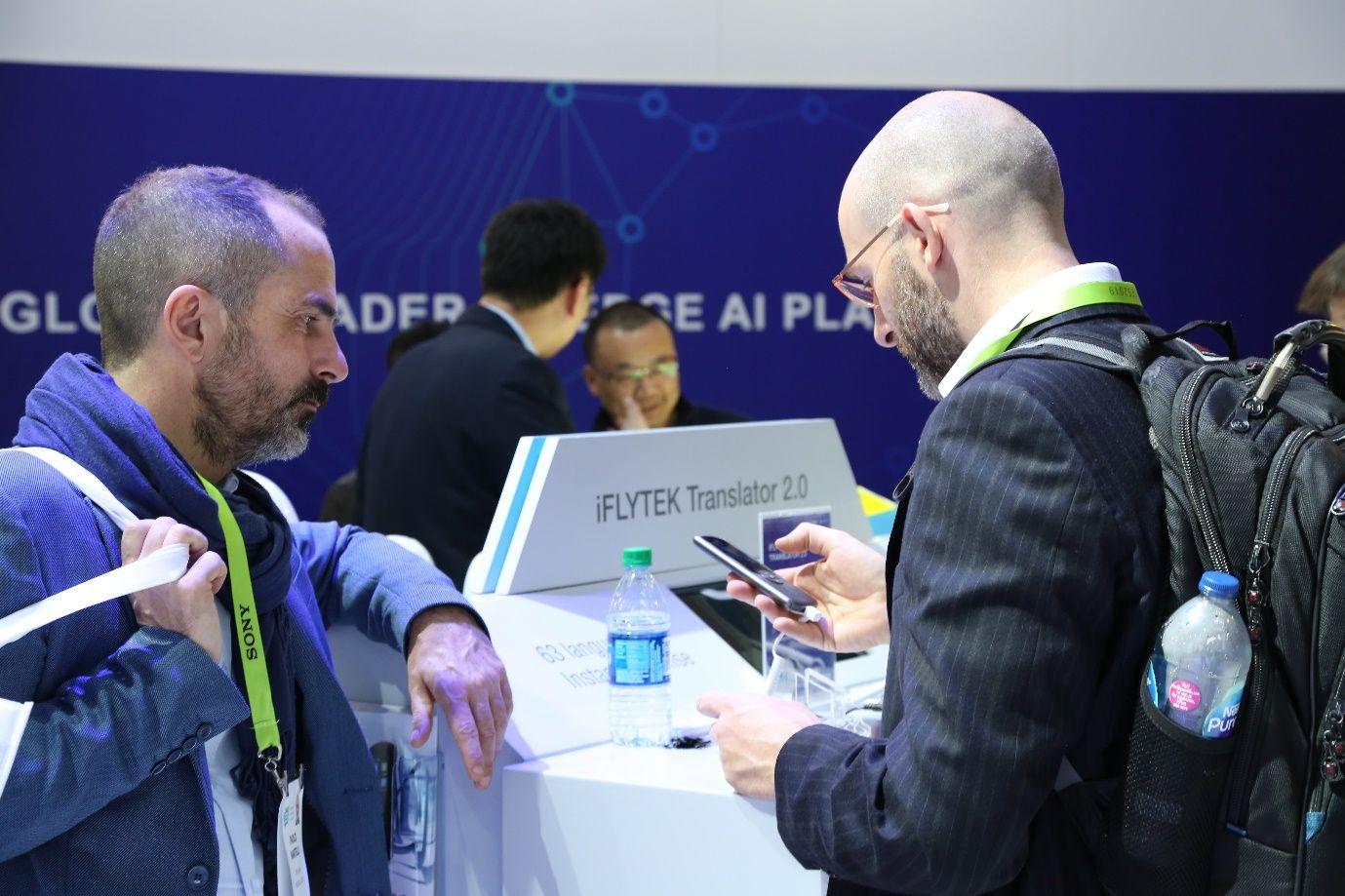
Attendees experience iFLYTEK Translator 2.0 at International Consumer Electronics Show 2019 in Las Vegas, U.S., Jan., 2019. (iFLYTEK)
BEIJING, April 24 (Xinhua) -- Gaston, a French elder whose son married a Chinese girl, had always been troubled with the problem of communicating with the family of his daughter-in-law. Fortunately, because of iFLYTEK Translator 2.0, the problem is solved. "With the gadget, I can choose toast in a bakery, chat with the hairdresser at the gate of my community, and I even held a French Christmas party. Thanks to iFLYTEK Translator, I can communicate with people freely in China. I love China, and I will come back," said Gaston.
Russian girl Natalia is an English teacher in Beijing Jiaotong University. When she traveled in Athens, the iFLYTEK Translator 2.0 she took with her turned out to be quite helpful. "Though I am proficient in English and Russian, they are useless in Greece. I had to resort to the machine when I asked for directions and ordered meals. When I ordered beer and snacks in a restaurant, I found the menu was in Greek. But the translator can translate for me accurately." She said, with the translator, she can share travel information and thoughts with her travel partners from Bulgaria and other countries, "It is a wonderful way to feel the pleasure of travel."
"What's the difference between a man without a dream and a salted fish?" At the product launch of iFLYTEK Translator 2.0 in April 2018, Zhai Jibo, product manager of iFLYTEK, translated a famous line of Stephen Chow's film into the above English by using the machine, reaping great applause.
In 2009, Zhai Jibo joined iFLYTEK to engage in product R&D. He said that the first generation of iFLYTEK Translator was well received after being released, but there was still room for improvement. The second generation came with the same price as the first one, yet with highly enhanced functions. The greatest highlight is the display screen. According to user feedback, the first generation had no screen, and users had to resort to mobile phone for network setting, causing inconvenience. What's more, users couldn't figure out the problems of translation. All these problems mean nothing with the arrival of the screen, and the new generation also supports camera translation. With image recognition technology, the Translator can translate foreign languages in the pictures shot by camera into Chinese. Currently, it supports photo identification of 11 languages, such as English, Japanese, and Korean.
According to Zhai, iFLYTEK Translator 2.0 currently supports the real-time inter-translation between Chinese and 50 other languages, meeting travel needs in nearly 200 countries and regions; it has also integrated AI technology. In specific scenarios such as medical care, finance, and computer, users can have more accurate translation by choosing patterns of "industry translator" or "general translator".
For such digital consumer goods to offer truly user-friendly experience to global users, it is important for the R&D team to ensure constant innovation for better details. According to Li Tianyang, member of iFLYTEK Translator team, in order to offer a translator that "speaks clearly, simply, accurately, and beautifully", the R&D team has combined neural machine translation, voice recognition, voice synthesis, image recognition, offline translation, 4-Mic Array, and other digital technologies to enhance translation accuracy. The technology roadmap has shifted from statistical machine translation to end-to-end neural machine translation, making translation smoother and more natural.
Yet at initial stage, they still encountered many problems, "The translation of Chinese family names was knotty. For instance, 'xiao', for which we can only find a pronunciation similar to 'she', and 'liu' reads 'Leo' in English. To make translated names more accurate and easier to understand, the R&D team overcame the problems one by one. They checked the pronunciation with English speakers again and again, to ensure Chinese names being pronounced in accordance with English rules while obtaining Chinese features," said Li Tianyang.
Considering that 30 percent home users cannot speak mandarin, and 63 percent speak mandarin with accent, iFLYTEK uses its long-accumulated dialect data to realize 95 percent recognition rate for mandarin with accent. The machine also supports the translation of Cantonese, Sichuan dialect, northeastern Mandarin, and Henan dialect.
As a powerful gadget facilitating communication among people of different countries, iFLYTEK Translator has been used on many occasions. We could find it at the Boao Forum for Asia, the 2018 EU-China Tourism Year, the Open House Day of the Chinese Mission to the EU, the World Internet Conference, the FIFA World Cup Russia 2018, and other events.
Since 2018, iFLYTEK has been invited to the International Consumer Electronics Show (CES), where attendees come to visit, consult, and experience. Just as what Liu Qingfeng, chairman of iFLYTEK has put it, "Language capacity is one of the drivers for us to push for the Belt and Road construction. With the latest AI technologies and products, we can communicate with the rest of the world freely. Based on full language communication and deeper understanding, we can build trust relationship and advance win-win cooperation."
Now more and more Chinese people choose independent travel, such as appreciating European classic paintings and sculptures in the Louvre, walking along the Danube, and enjoying Russian culture in St. Petersburg. There are also a growing number of foreigners who want to come to China for the Imperial Palace, the Great Wall, the landscape of Guilin, Suzhou and Hangzhou, and Chinese food. All these have become simpler thanks to the wonder of technological innovation. Scientific and technological progress is enabling smoother people-to-people communication and bringing a better life. (Contributed by Luo Hao, Zhang Ziyun, edited by Yang Yifan)




 A single purchase
A single purchase









